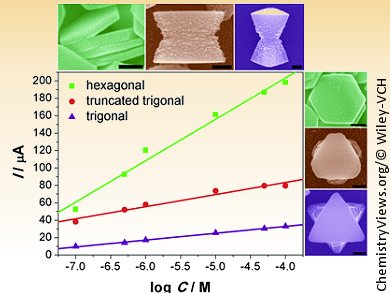Histidine-containing compounds have the potential to be anti-inflammatory therapeutic agents for a range of diseases, including bacterial meningitis. Therefore, the sensitive detection of l-histidine is very important. L. Li, L. Guo, and co-workers, Beihang University, China, have investigated the electrocatalytic performance of Ni(OH)2 nanostructures towards l-histidine by using cyclic voltammetry.
The properties of nanomaterials are strongly dependent on their size, shape, and nanostructures, and so hexagonal, truncated trigonal, and trigonal hourglass-like nanostructures were compared as electrode modifiers. The electrocatalytic activity was found to depend on both the external architecture and the internal degree of crystallinity of the structures. The hexagonal Ni(OH)2-based biosensor showed the best electrocatalytic activity, as well as excellent sensitivity and selectivity for the determination of l-histidine.
This is promising for the analytical application of this technique in real biological samples and may also enable the design of new and better electrocatalytic materials by using shape-controlled nanoparticles.
- Structure-Dependent Electrocatalysis of Ni(OH)2 Hourglass-like Nanostructures Towards L-Histidine,
Jianwei Nai, Zhengbo Chen, Haopeng Li, Fangyuan Li, Yang Bai, Lidong Li, Lin Guo,
Chem. Eur. J. 2012.
DOI: 10.1002/chem.201203009



![Synthesis of [c2]Daisy Chains via Mechanochemistry](https://www.chemistryviews.org/wp-content/uploads/2025/04/202504_RotaxanesWithSolidStateMechanochemistry-125x94.png)
